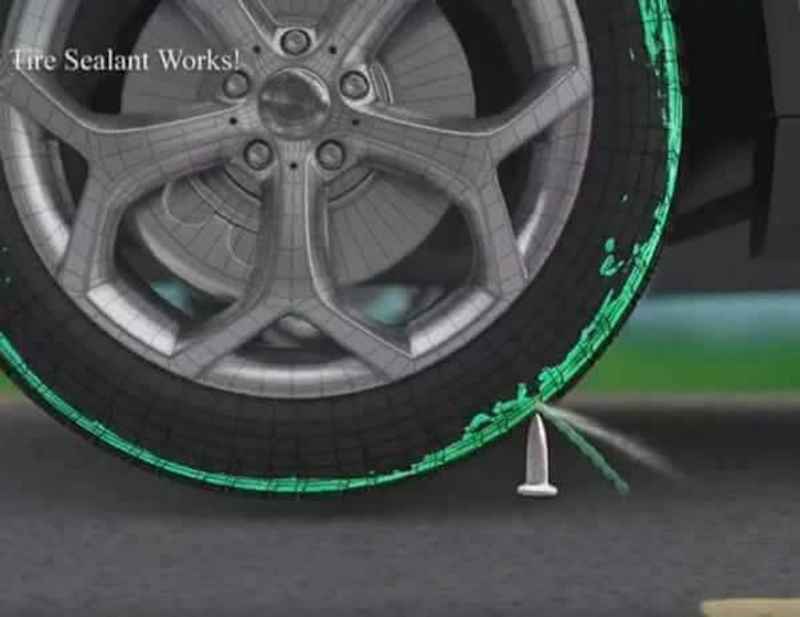What if we told you that there was a way that your punctures could repair themselves? No need to get off and change or repair your tyres. Just keep driving and the puncture seals itself. Sounds like stuff from the movies? Well, what if we told you that this technology exists even today and is accessible for a very small price. Yes, we're talking about none other than tyre sealants.
How do sealants work?
Sealants often come in cans or bottles that contain a fibrous liquid that can be pumped into your tyre through the tyre valve. A simple tube connects the sealant bottle to your valve and it's ready to be pumped.
Once inside your tyre, the sealant stays in the tyre as a liquid and gradually coats the inside of the tyre. Thus, whenever a puncture happens, the sealants gets pushed into the hole due to leaking air pressure and the centrifugal force. This forces the sealant to enter the hole and leak a little from the tyre. As it leaks, the fibres and thickeners from the sealant clog the hole, similar to how your blood clots up whenever you get hurt.
Basically, when a puncture occurs, the internal pressure of the tyre instantly pushes the sealant into the cavity and the special fibres and mica particles in the sealant accumulate and bond to the rubber in the cavity. This leads to the formation of a solid rubber plug is formed through the full depth of the puncture hole.
We know what you're thinking, "there's no way in hell I'm putting that liquid inside my tyre! It's going to ruin my tyre for sure." Well, hold your horses. You see the liquid adds very little weight and takes up extremely little space relative to your entire tyre. It's just a thin layer inside your tyre. The difference in air pressure and added weight is negligible. What's more, if you put it in a balanced tyre, and the amount per tyre is correct, the balance will be maintained and the sealant will do its job.
Chemical Composition Of Sealants

Tyre sealants have a liquid base which has fibers and particles suspended within it. This liquid is usually glycol or latex. Organic thickeners, binding agents, mica, rubber particles and cellulose fibres of different types are suspended with this liquid. The mica particles and fibres, which vary from ceramic, wool to aramid (Kelvar), determine the strength of the solution. The thickeners along with the particles and fibres are responsible for plugging the hole in the event of a puncture. The stronger the solutions sealing capacity, the denser the mix of fibres and rubber. The composition is adjusted in viscosity to match various applications and conditions.
The glycol/latex is the carrier of the fibres that form the solid plug. Contracting and expanding of the cavity due to the tyres normal behaviour squeezes the glycol/latex from the plug. This allows the fibres, mica and thickeners to bond and form a solid plug. The remaining solution in the tyre continues to coat and protect the tyre from hundreds of other punctures.
Also Read: Should You Use Tyre Sealants ? Pros And Cons Explained
Glycol Vs Latex - Which one should you go for

Latex sealants are usually cheaper since they have a lower production cost and don't require as many additives. However, latex dries up after approximately 15000 kilometres and is a pain to remove after it's dried up. It completely ruins the tyre and wheel after drying which means you'll have to get the pair replaced. It also causes damage and corrosion due to its high concentration of ammonia.
Glycol sealants, on the other hand, are water-based. They are more expensive but they are also more tyre friendly and can be easily removed with water. They are non-toxic and non-flammable. Glycol is a water-based substance that can be either ethylene glycol or propylene glycol. Propylene is non-toxic and Ethylene is toxic.
Glycol sealants also act as corrosion retardants and inhibit tyre degradation, thereby promoting higher rates of success during re-treading. They also reduce running temperature and their superior sealing capability makes them a highly efficient solution for tyre maintenance that is also cost-effective.
The nature of the fibres and the Glycol are what determine the quality, strength and longevity of Glycol sealants.
We suggest that you buy sealants with Propylene Glycol and not Ethylene or Latex. Latex can ruin your wheels completely and only works for a small amount of time. It's less stable and more corrosive. Ethylene is toxic too so that's a big NO as well.
Go for good strong fibres like Aramid Fibres (Kevlar), Ceramic, Woolen, and other synthetic fibres. Look for the quantity of fibres (higher density means a better sealant). Crushed Marble and Mica particles are also good materials to have.